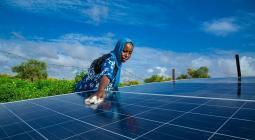Kenya: A renewable energy hub with frequent blackouts
Kenya boasts around 87% renewable energy generation, yet its citizens are left fumbling in the dark. Experts say frequent nationwide power outages in recent months show weaknesses in the system that need attention.
"It is a pity that the whole of Kenya can go to a blackout," Mulei Collins, a resident of Nairobi, Kenya's capital, told DW.
The most recent nationwide blackout in mid-December marked the third in as many months, leaving Kenyans perplexed and frustrated.
"Having power blackouts is very normal. But to what extent, and to which level, does this event or occurrence exist?" said Charles Onyango, a Nairobi-based urban development consultant.
"The problem is about governance. Poor governance leads to poor service delivery," he told DW. "Personally, when the power goes, it affects my normal schedules and programs."
Dancan Oluoch, an environmental science student based in Nairobi, agrees that the blackouts cause significant overall disruption to life in the East African country.
"When blackouts come, it finds many people unprepared. So it hinders the transaction in terms of business," Oluoch said.
A fragmented energy sector
Kenya's energy sector relies heavily on renewables such as geothermal and wind energy. But experts say there are potential weaknesses in the system.
According to Victor Kenga, a renewable energy expert, the fragmented nature of the energy sector presents challenges that may not exist in a more centralized setting.
"It should be looked at that we don't have a lot of monopolization in Kenya power and KenGen," Kenga said.
Experts say a lack of clear leadership on energy further muddles the picture. Kenya also has an energy minister and a principal secretary in charge of energy and various departments.
Cabinet Secretary for Energy and Petroleum David Chirchir has blamed the nationwide power outages on overloaded transmission lines.
"Sometimes the network trips when it is overloaded, there was sudden demand in the line between Kisumu and Muhoroni and cascaded down to the rest of the country," Chirchir said.
The government has just approved a new transmission line, funded by the African Development Bank and Japan to the tune of some 66-billion-shilling ($420 million, €382 million). The project is expected to be completed within 20 months.
The president's vision vs. reality
However, poor infrastructure is not only limited to the energy sector.
Despite increased generation capacity, transmission and distribution networks have not kept pace. This has led to a situation where there are pockets of excess power in some regions while others face crippling shortages.
President William Ruto has championed sustainable solutions, yet the recent blackouts overshadow Kenya's ambitions.
But despite his optimism, the evidence of endemic outages means realizing its ambitious vision for a reliable and sustainable energy future. Kenya still has hurdles to overcome.
Cover photo: A woman pictured in the glow of an emergency light during a power outage in Kenya in August 2023.Image: Abdul Azim Sayyid/AP/picture alliance





